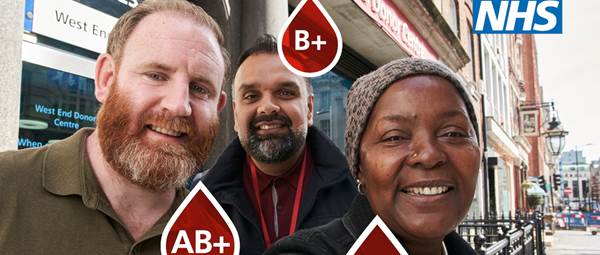 Abraham Lincoln
If given the truth, the people can be depended upon to meet any national crisis...
Abraham Lincoln
If given the truth, the people can be depended upon to meet any national crisis...
 Guildford news...
for Guildford people, brought to you by Guildford reporters - Guildford's own news service
Guildford news...
for Guildford people, brought to you by Guildford reporters - Guildford's own news service
Notice: More Than 2,600 New Blood Donors Are Needed in Surrey to Meet Demand
Published on: 15 Jun, 2022
Updated on: 15 Jun, 2022
 National Blood Week
National Blood Week
- New five-year Blood Strategy focusses on increasing number and diversity of donors
- Urgent need for more Black African, Black Caribbean and younger donors in Surrey
- Mass public campaign to identify people with the most needed blood types
- Sign up at blood.co.uk or on the GiveBloodNHS app
NHS Blood and Transplant are urging people in Surrey to give blood as new targets reveal 2,632 new donors are needed in the area to save lives over the next year.
Nationally one million more blood donors are needed over the next five years to ensure patients receive the right type of blood to save and improve their lives, with a particular need for Black African, Black Caribbean and younger donors.
The five-year Blood Service Strategy, published at the start of National Blood Week, sets ambitious plans to recruit up to a million new donors and double the number of regular donors with the rarest blood types. This will ensure better-matched blood types for patients in the future and reduce health inequalities.
 Most people know the main blood types – O positive (35 per cent of the population), O negative (13 per cent), A positive (30 per cent), A negative (8 per cent), B positive (8 per cent), B negative (2 per cent), and AB positive (2 per cent). But the public is less familiar with the many sub-types that can provide an even better match to improve their treatment.
Most people know the main blood types – O positive (35 per cent of the population), O negative (13 per cent), A positive (30 per cent), A negative (8 per cent), B positive (8 per cent), B negative (2 per cent), and AB positive (2 per cent). But the public is less familiar with the many sub-types that can provide an even better match to improve their treatment.
There is a particular urgency for more donors of Black African and Black Caribbean ethnicity to treat people with sickle cell. Sickle cell is the fastest growing genetic blood disorder in the UK and mostly affects people of Black heritage. It requires regular transfusions – most often with the specific blood sub-type Ro.
Most patients are children, and demand for Ro blood is projected to double from 2016/17 – 2025/26. Fifty-five per cent of Black blood donors have the Ro subtype compared to 2.4 per cent of donors from other ethnicities.
Recent Articles
- Guildford Institute’s Crowdfunding Project for Accessible Toilet in its New Community and Wellbeing Centre
- Letter: Guildford – Another Opportunity Missed?
- Letter: GBC’s Corporate Strategy – Where Is the Ambition?
- My Memories of John Mayall at a Ground-breaking Gig in Guildford Nearly Six Decades Ago
- Westborough HMO Plans ‘Losing the Heart of the Street’ Says Resident
- College Invests to Boost Surrey’s Economy and Close Digital Skills Gap
- Community Lottery Brings Big Wins for Local Charities
- GBC Housing Plan Promises ‘A Vibrant Urban Neighbourhood’ Near Town Centre
- Hospital Pillows ‘Shortage’ at the Royal Surrey
- Updated: Caravans Set Up Camp at Ash Manor School


Search in Site
Media Gallery
Dragon Interview: Local Artist Leaves Her Mark At One of England’s Most Historic Buildings
January 21, 2023 / No Comment / Read MoreDragon Interview: Lib Dem Planning Chair: ‘Current Policy Doesn’t Work for Local People’
January 19, 2023 / No Comment / Read MoreA3 Tunnel in Guildford ‘Necessary’ for New Homes, Says Guildford’s MP
January 10, 2023 / No Comment / Read More‘Madness’ for London Road Scheme to Go Ahead Against ‘Huge Opposition’, Says SCC Leader
January 6, 2023 / No Comment / Read MoreCouncillor’s Son Starts Campaign for More Consultation on North Street Plan
December 30, 2022 / No Comment / Read MoreCounty Council Climbs Down Over London Road Works – Further ‘Engagement’ Period Announced
December 14, 2022 / No Comment / Read MoreDragon Interview: GBC Reaction to the Government’s Expected Decision to Relax Housing Targets
December 7, 2022 / No Comment / Read MoreHow Can Our Town Centre Businesses Recover? Watch the Shop Front Debate
May 18, 2020 / No Comment / Read More









Recent Comments